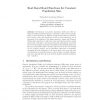Free Online Productivity Tools
i2Speak
i2Symbol
i2OCR
iTex2Img
iWeb2Print
iWeb2Shot
i2Type
iPdf2Split
iPdf2Merge
i2Bopomofo
i2Arabic
i2Style
i2Image
i2PDF
iLatex2Rtf
Sci2ools
GECCO
2003
Springer
2003
Springer
Real Royal Road Functions for Constant Population Size
Evolutionary and genetic algorithms (EAs and GAs) are quite successful randomized function optimizers. This success is mainly based on the interaction of different operators like selection, mutation, and crossover. Since this interaction is still not well understood, one is interested in the analysis of the single operators. Jansen and Wegener (2001a) have described so-called real royal road functions where simple steady-state GAs have a polynomial expected optimization time while the success probability of mutation-based EAs is exponentially small even after an exponential number of steps. This success of the GA is based on the crossover operator and a population whose size is moderately increasing with the dimension of the search space. Here new real royal road functions are presented where crossover leads to a small optimization time, although the GA works with the smallest possible population size – namely 2.
| Added | 06 Jul 2010 |
| Updated | 06 Jul 2010 |
| Type | Conference |
| Year | 2003 |
| Where | GECCO |
| Authors | Tobias Storch, Ingo Wegener |
Comments (0)

